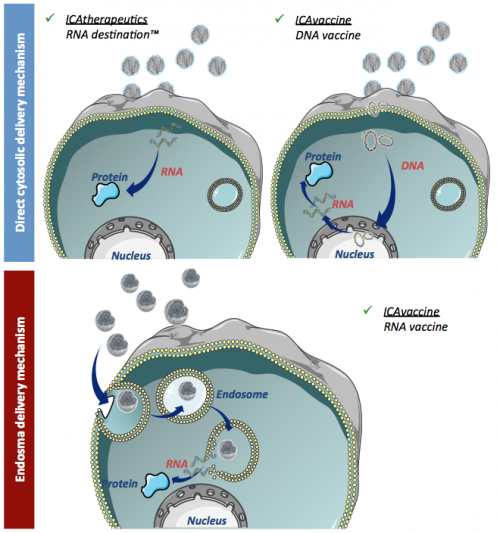Nanotaxi® elaborated by synthetic organic chemistry
Nanotaxi® is a trademark including hundreds of compounds belonging to different chemistry families (lipids, polymers) that are synthesized using organic chemistry. Some compounds have similar structures to known pharmaceutical excipients or drugs.
- Amphiphilic compounds that self-assemble with nucleic acids to form supramolecular structures
- Controlled delivery mechanism of DNA or RNA molecules inside cells ; i.e. direct through plasma membrane or endosomal pathway
- Purity obtained after synthesis is superior to 98% ; full package of chemical and physico-chemical characterization (MS, NMR, UPLC, DLS) is performed for each batch, as well as stability studies
- Excellent safety profile, shown in preliminary safety toxicological studies . No immune response against Nanotaxi®
Several In-Cell-Art Nanotaxi® are currently being synthesized under GMP conditions: scaling-up, process development and demo batches have already been tested and validated for vaccines and therapeutics.
Initial industrial production allowed for the preparation of Nanotaxi® on multigram scale (potentially corresponding to million doses of human vaccines).
Nanotaxi® and their use to deliver macromolecular dugs are protected by international patents.

Nanotaxi® enables autonomous delivery and controls the innate immunity response
Natural recognition of nucleic acids within cells
Nature has designed different intracellular mechanisms to sense the presence within cells (endosome, cytosol) of nucleic acids such as DNA and RNA. This corresponds to the natural detection of foreign nucleic acids that leads to the activation of the innate immune system (danger signal) and expression of cytokines and interferon.
Autonomous delivery mechanism controlling innate immune response
Depending on the therapeutic or vaccine applications and macromolecular drugs (DNA vs RNA) to be transported, Nanotaxi® is designed to lead either to a cytosolic or to a endosomal delivery mechanism allowing to prevent or stimulate the innate immune stimulation.

